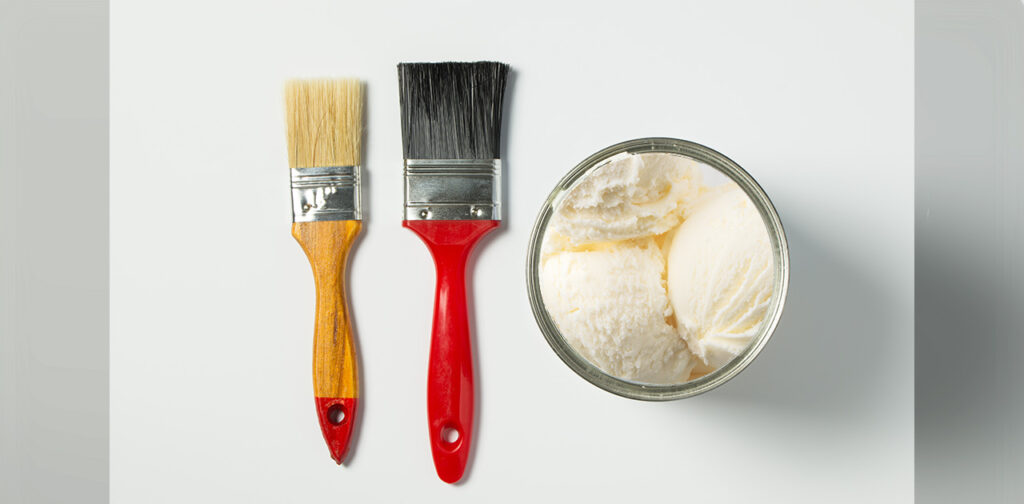
Not every paint or painter is the same. Here’s how a gallon of paint is like a gallon of ice cream.
Remember where you were the first time you had a bad haircut? Maybe it was high school and your mom thought the new hairstyle place would be just fine. Or what happened after you decided to save on that oil change by going to the quick-fix place close to work? How about the time you tried saving a few bucks on shoes and they fell apart halfway through a big race or walk to the office?
It’s easy to see why. Of course the haircut was bad because mom gave lousy direction and the stylist was new and didn’t know what questions to ask. Of course the mechanics over-tightened the oil pan valve and busted it because they were in a hurry. Of course the shoes fell apart, they were buy-one-get-one!
Yet somehow, some things escape our lived experiences and we still try to cut corners. People do it with legal services and painters, but rarely medical care or education. But why?
We think it has something to do with a lack of understanding about the work. In the painting industry, it’s easy for people to assume we show up at your house with some rollers and a bucket of paint and start glomming it onto the walls. At best some worker throws down some plastic sheets to catch drippings.
It just looks so easy.
There’s far more to it. For one, anyone who has ever painted a room knows it’s not “easy”, otherwise we’d all just paint our bathrooms on a whim like we change out the curtains.
The longevity of your home’s paint job is directly related to the skill of the painter and the quality of the paint materials.
What ice creams shows us about paint
The best ice cream — the really good stuff that costs $6 a container — is made with fuller-fat creams. You can test this by microwaving or melting a spoonful. See how much actual cream is left in the bowl vs. cheaper ice creams that are comparatively similar in container size, but contain more whipped air, fewer fats, and skim milk. If you’re going to eat ice cream, you want ice cream, not air!
A gallon of paint is similar. Higher-quality paints give more coverage per square foot than cheaper paints. They also touch up better and simply have a longer life more resistant to cracks, chips, and being touched or abused by climate. Like ice cream, the higher-quality paints just use better mixes — except with pigments, resins, and binders instead of cream and Oreos.
Paint quality comes in grades and while every manufacturer you’ve heard of makes inexpensive paints, they do so only because market forces demand it. After all, someone’s out there buying fat-free ice cream, but that’s hardly worth calling ice cream.
A $15/gallon paint might cover the walls, but it won’t hold up to cleaning or water. You’ll be back painting the whole wall again in a year. Whereas a $40 or $50/gallon paint has a higher density of pigments, more resin, and less water. Meaning you can clean it with a damp cloth or wipe off water now and again.
This carries over to exterior home paint, too. Having paint that can withstand more than a little humidity or rain is crucial to the longevity of the siding, wood, or surface underneath. $40 for a gallon of paint today means not having to replace the siding or eaves for thousands tomorrow.
How skilled painters save time and money
Like a chef preparing a meal versus you and a microwave, the talent of the person doing the work and the equipment they have matters. We know this in any human endeavor. And in most every instance, there are things all professionals do right.
Foremost is preparation. Wiping down surfaces and cleaning everything before applying paint is an easy one for most people to skip. “Looks clean enough” doesn’t cut it for Woodiwiss.
How the paint is applied can save time when done right, such as using stilts or personal lifts instead of setting up and moving a ladder every few strokes. Special equipment helps us keep our rollers and brushes moving and efficient, meaning less time wasted and more time getting work done..
We train everyone on our team what kind of brushes and rollers to reach for — like synthetic vs natural brushes when paired with paint mixes — so the right surface is achieved. This matters if you want a texture, or not, and whether the underlying surface, such as wood, needs to shine through. We also train our crews how to thicken or thin paints, how to stir without making a mess, and how to handle all sorts of unforeseen situations, like improperly patched walls.
Smaller brushes are cheaper, but they take longer to do the work. Some rollers are cheaper than others, too, but they come with lousy plastic handles that are stiff and cause stress and wear on the painter’s hands, something we’re keen to avoid.
Then there’s scheduling. When a space is being painted it’s basically unusable because of either a lack of usable furnishings or the smell of paint fumes. That downtime — particularly for offices and businesses — has a cost. Cheap paints mean you’re right back to all that downtime again in half the time as a solid paint job the first go-around.
Through a combination of top-of-the-line materials, training, tools, and methods for home and office painting, Woodiwiss pays attention to quality first. The result is always better value and long-lasting success, even if the initial price looks higher on paper than competitors.
